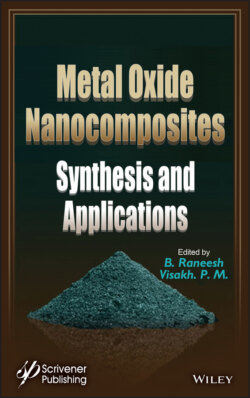Читать книгу Metal Oxide Nanocomposites - Группа авторов - Страница 2
Table of Contents
Оглавление1 Cover
2 Title Page
3 Copyright
4 Preface
5 1 Metal Oxide Nanocomposites: State-of-the-Art and New Challenges 1.1 Introduction to Nanocomposites 1.2 Graphene-Based Metal and Metal Oxide Nanocomposites 1.3 Carbon Nanotube−Metal Oxide Nanocomposites 1.4 Metal Oxide-Based Nanocomposites Application Towards Photocatalysis 1.5 Metal Oxide Nanomaterials for Sensor Applications 1.6 Metal Oxide Nanocomposites and its Thermal Property Analysis 1.7 Semiconducting Metal Oxides for Photocatalytic and Gas Sensing Applications 1.8 Applications of Metal Oxide-Based Nanocomposites References
6 2 Introduction to Nanocomposites 2.1 Composites: An Introduction 2.2 Functions of Fibers and Matrix 2.3 Classification of Composites 2.4 Matrix Based Composites 2.5 Reinforcements 2.6 Polymer Composites 2.7 Composites Processing 2.8 Composites Product Fabrication 2.9 Application of Composites 2.10 Special Features of Composites 2.11 Composites vs Metals 2.12 Advantages of Composites 2.13 Disadvantage of Composites 2.14 Conclusion Acknowledgments References
7 3 Graphene-Based Metal and Metal Oxide Nanocomposites 3.1 Introduction 3.2 Graphene 3.3 Reduced Graphene Oxide 3.4 Graphene-Based Composites 3.5 Graphene-Based Hybrid Nanocomposites 3.6 The Mechanics of Graphene Nanocomposites 3.7 Functionalization 3.8 Thermal Properties 3.9 Conclusions References
8 4 Carbon Nanotube−Metal Oxide Nanocomposites 4.1 Introduction 4.2 Synthesis Methods 4.3 Environmental Applications 4.4 Environmental Fate, Transport, and Transformation 4.5 Environmental Implications 4.6 Conclusions and Future Research Direction References
9 5 Metal Oxide-Based Nanocomposites Application Towards Photocatalysis 5.1 Introduction 5.2 Nanocomposite Photocatalysts Based on Metal Oxide 5.3 Application of Metal Oxide Composites in Photocatalysis 5.4 Summary and Outlook References
10 6 Metal Oxide Nanomaterials for Sensor Applications 6.1 Introduction 6.2 Binding of Metal Oxide with Imidazole 6.3 Characterizations 6.4 Absorption Characteristics 6.5 Emission Characteristics 6.6 Sensor Mechanism 6.7 Conclusions References
11 7 Metal Oxide Nanocomposites and its Thermal Property Analysis 7.1 Introduction 7.2 Metal and Metal Oxide Nanoparticles in Thermal Management 7.3 Synthesis Procedures 7.4 Mechanism of Thermal Conductivity Enhancement 7.5 Thermal Conductivity Models for Nanofluids References
12 8 Semiconducting Metal Oxides for Photocatalytic and Gas Sensing Applications 8.1 Semiconducting Metal Oxide as Photocatalysts 8.2 Semiconducting Metal Oxide as Gas Sensor 8.3 Conclusion Acknowledgments References
13 9 Applications of Metal Oxide-Based Nanocomposites 9.1 Introduction 9.2 Food and Agricultural Sector 9.3 Applications in Medicine 9.4 Water Barrier Properties 9.5 Thermal and Flame Retardants Apparitions 9.6 Water Disinfection Ability 9.7 Water Flux Application 9.8 Nanocomposites Membrane Apparitions 9.9 Wastewater Treatment 9.10 Non-Solvent Induced Phase Separation 9.11 Adsorption Performances Apparitions 9.12 Electrocatalytic Applications 9.13 Biosensors Application 9.14 Sensing Applications 9.15 Other Industrial Appreciations 9.16 Conclusions References
14 10 Triboelectric Nanogenerators for Energy Harvesting and Sensing Applications 10.1 Introduction 10.2 What is Triboelectric Effect? 10.3 Mechanism of Triboelectric Nanogenerator (TENG) 10.4 How to Select the Materials for Your TENG? 10.5 Basic Operating Modes of TENG 10.6 TENG as Mechanical Energy Harvester 10.7 Conclusion and Future Perspectives References
15 11 Metal Oxide Nanocomposites for Wastewater Treatment 11.1 Introduction 11.2 Adsorptive Removal of Water Pollutants 11.3 Photocatalytic Decomposition of Water Pollutants 11.4 Metal Oxide Nanocomposites 11.5 Removal and Decomposition of Inorganic Pollutants by Metal Oxide Nanocomposites 11.6 Removal and Decomposition of Organic Pollutants by Metal Oxide Nanocomposites 11.7 Conclusion and Outlook References
16 Index
17 End User License Agreement
